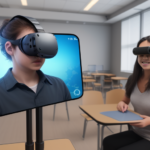The Rise of Augmented Reality (AR) and Virtual Reality (VR) in Education
The Rise of Augmented Reality (AR) and Virtual Reality (VR) in Education
Introduction to AR and VR:
Augmented Reality (AR) and Virtual Reality (VR) are two rapidly evolving technologies that are making a significant impact on various industries, including education. AR involves adding digital elements to a live view often through the lens of a smartphone or a specialized AR headset. On the other hand, VR creates a completely immersive digital environment that can be experienced through VR headsets. These technologies have the potential to transform the way students learn by providing interactive and engaging experiences that were once thought to be impossible.
Benefits of AR and VR in Education:
1. Enhanced Learning Experiences: AR and VR technologies allow students to interact with digital content in a more immersive way, making learning more engaging and enjoyable.
2. Visualizing Complex Concepts: Difficult concepts can be better understood through visual aids and simulations created using AR and VR, helping students grasp abstract ideas more effectively.
3. Increased Engagement: The interactive nature of AR and VR applications can capture students’ attention and motivation, leading to improved focus and retention of information.
4. Accessibility and Inclusivity: AR and VR tools can cater to different learning styles, making education more accessible to students with diverse needs.
5. Real-World Applications: Students can explore real-life scenarios and practical applications of what they learn in the classroom through AR and VR simulations, enhancing their understanding of the subject matter.
Examples of AR and VR Use Cases in Education:
1. Virtual Field Trips: Schools can use VR technology to take students on virtual field trips to historical sites, museums, or even outer space without leaving the classroom.
2. Interactive Simulations: AR and VR can be used to create interactive simulations for science experiments, historical events, or even engineering projects, providing hands-on learning experiences.
3. Language Learning: AR applications can overlay translations, phonetics, or cultural information in real-time, making language learning more interactive and engaging.
4. Medical Training: VR simulations are increasingly being used in medical education to train students in surgical procedures, patient care, and anatomy studies in a realistic yet safe environment.
5. Skill Development: AR and VR tools can help students develop practical skills such as problem-solving, teamwork, and critical thinking through gamified experiences and simulations.
Challenges and Considerations in Implementing AR and VR in Education:
1. Cost: The initial investment in AR and VR technology can be substantial, including the purchase of hardware, software development, and training for educators.
2. Technical Infrastructure: Schools need to have the necessary technical infrastructure, such as high-speed internet and compatible devices, to support the seamless integration of AR and VR tools in the classroom.
3. Content Development: Creating high-quality and relevant content for AR and VR applications requires expertise and resources, which may pose a challenge for educators and institutions.
4. Educator Training: Teachers may require training to effectively integrate AR and VR technologies into their teaching practices and to facilitate meaningful learning experiences for students.
5. Ethical and Privacy Concerns: The use of AR and VR in education raises concerns about data privacy, content appropriateness, and potential security risks that need to be addressed to ensure a safe learning environment for students.
Future Outlook of AR and VR in Education:
The future of AR and VR in education looks promising, with more educators and institutions exploring innovative ways to integrate these technologies into the curriculum. As the technology continues to evolve and become more accessible, we can expect to see a greater adoption of AR and VR tools in classrooms worldwide. This shift towards immersive and interactive learning experiences has the potential to revolutionize education and better prepare students for the challenges of the 21st century.

